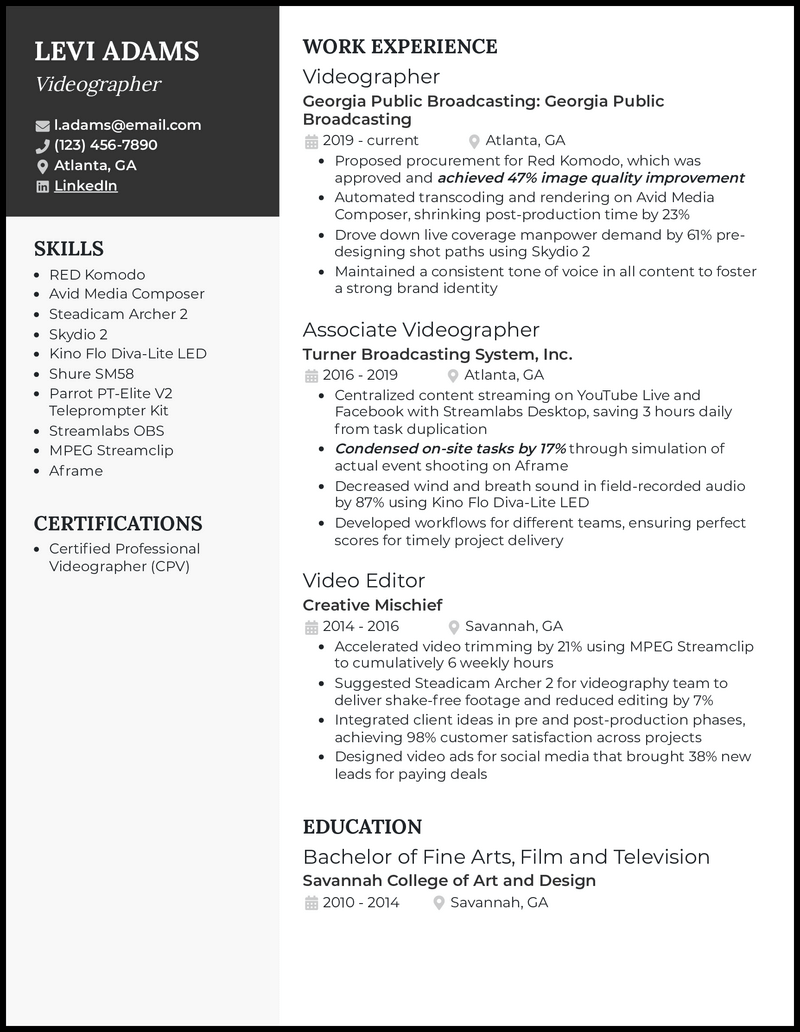Stunning scenery shots, heartwarming clips of a client’s wedding, that gripping short film, or the top-quality footage you got at the last business conference? All you!
You might be wondering how to write a cover letter as well as represent your creative abilities on your resume. Which resume template should you use, and what skills and qualifications do recruiters want to see?
We’ve got just the solution! After years of helping multimedia professionals like you, we’ve created our three videographer resume examples to help you compose the career you want.
Related resume examples
What Matters Most: Your Skills & Work Experience Sections

Your job skills might range from basic camera usage to fancy drone shots, how to get the perfect on-brand lighting, and much more! Recruiters like a well-curated skills list they can skim at a glance.
Be as specific as you can about your skills so that your videography abilities aren’t flat, making your resume sound generic. If you worked with a team, that’s great! But try to work “production team” into your work experiences later instead of listing vague stuff like “teamwork.”
Alongside being industry-specific, make sure each particular skill is specialized. You want to demonstrate what a unique candidate you are! And you should revisit the job description to tailor your skills to what your potential employer wants.
9 top videographer skills
- RED Komodo
- Streamlabs OBS
- Skydio 2
- MPEG Streamclip
- Aframe
- Stedicam Archer 2
- Avid Media Composer
- Agility/Dexterity
- Deadline Management
Sample videographer work experience bullet points
What a great snapshot of your skills! But once you’re done listing your abilities, recruiters want to see some examples of how you’ve used them to improve your workplace.
To demonstrate your ability to fit into the new role perfectly, look at the organization’s website where you’re applying and read through some of its pages. Where do your success points match up with its current goals?
Each example should align with the job description by mentioning camera work, creative decision-making, and other aspects of the videographer’s role. And those examples need metrics!
Quantifiable data that shows how your work has left a positive impact in your field will make your resume shine as brightly as that gorgeous sunset shot:
- Proposed procurement for RED Komodo, utilizing it upon approval to help achieve a 47% image quality improvement
- Maintained a constant tone of voice in all content to foster a strong branding identity, earning a personal studio employee rating of 4.9/5 stars
- Suggested Steadicam Archer 2 for videography team to deliver shake-free footage and reduced editing time by an average of 12 hours per week
- Integrated client ideas in pre and post-production phases, achieving a 98% customer satisfaction rate across projects
Top 5 Tips for Your Videographer Resume
- Stay on focus
- Recruiters skim, so make sure you list your points in a way that flows and delivers your key qualifications ASAP! Double-check your experience points to ensure clarity and concision.
- Use a layout with a “centerpiece”
- You want to put your crowning videographer achievements at the center of attention on your resume. If your skills are super impressive, or if you have many other qualifying categories to go alongside them, like your education or certifications, use a resume template with a side column! A more centered layout might be best if you have an extensive history of achievements.
- Use references if you have them
- If you’ve worked in videography before or are a new graduate, you might have previous employers or professors who can back up your determination and technical prowess behind the camera. If you can get a few professional references, you’ll boost your resume’s credibility points!
- Mention any notable projects
- Your experiences don’t all have to be paid jobs. Recall any internships, academic awards, or volunteer initiatives that featured your Aframe expertise or furthered your agility with Adobe Premiere Pro’s features during post-production.
- Answer, don’t repeat
- When referring to the job description so frequently, don’t fall into the trap of just echoing what you’ve read! Instead of repeating what’s in the job requirements, complement each piece with a correlating achievement of your own.
Refer to the organization’s website and the original job description and get a great feel for the company culture. Look for mission statements you resonate with, like bringing a new creative edge to the industry, and look for bits of personality that show up in their writing.
Avoid weak ones that don’t support the final impact you made in your example point. Random numbers of projects or team headcounts can help, but that shouldn’t be all. Reinforce the final point demonstrating how your steady hands and software prowess made a difference.
If you’re new to your field or changing careers, an objective statement can give valuable insight into why you want the job and what qualifies you. If you’re an experienced videographer, assess whether your experiences stand best alone or look more cohesive with a resume summary to tie them together.








